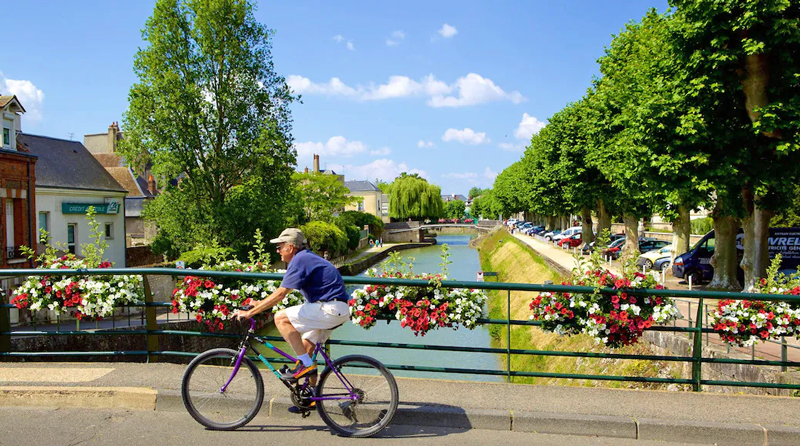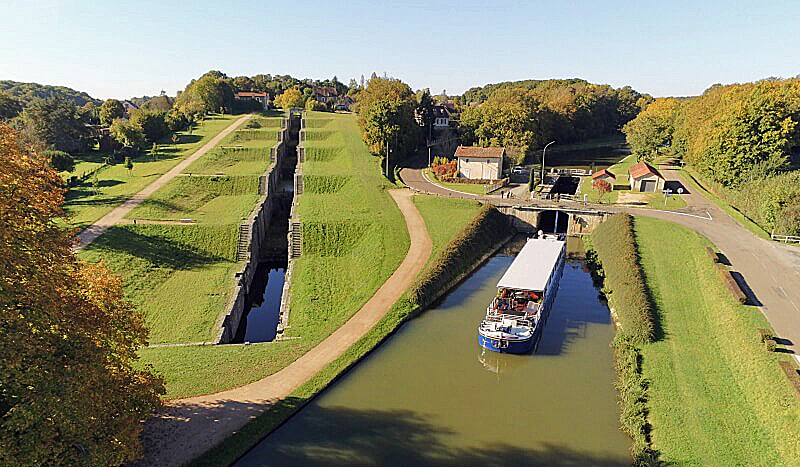Barging in France: The Canal de Briare
Part 2: Towns & Villages Along the Canal de Briare
The picturesque Canal de Briare, one of the oldest canals in France, connects the valleys of the Seine and the Loire. The Canal de Briare begins just north of Montargis at Buges. The section of the canal between Montargis and Rogny follows the valley of the River Loing. Many of the villages and hamlets date earlier than the origin of the canal.
[ Montargis | Montcresson | Montbouy | Châtillon-Coligny | Rogny-les-Sept-Écluses | Briare | Pont Canal de Briare | Châtillon-sur-Loire ]

Montargis is one of the “villes fleuries”, a designation awarded to towns and villages with fabulous floral displays. Also known as the “Little Venice of France”, many small canals dissect this lively and attractive town. The Canal de Briare wends its way right through the center of Montargis, with its banks behind the 17th century houses. The town’s museums provide a wealth of information on local arts and traditions. During the reign of Louis XIII, a local chef invented a confection made from roasted almonds covered with sugar, which became known as pralines.
The origins of Montcresson are uncertain, though two relics of an ancient settlement, a pierced stone and a tumulus (a burial mound), were found in the vicinity. Within the town itself, there are several 13th century buildings, including the church, castle, and a former convent.
During the construction of the canal in Montbouy, engineers uncovered the remains of a 2nd century Gallo-Roman bathhouse and an amphitheater which had a capacity of 4000. The 11th century church has seen many alterations since its construction, the last being in the 17th century. The church was added to the list of Historic Monuments in 1967. Originally, there were two locks separated by a little lake, which were replaced by one lock in 1892. Today, we can still see one of the old locks without its gates.
Châtillon-Coligny, once known as the town of Châtillon, entered the ownership of the Coligny family in 1437. Because the four Coligny sons were Protestant, the town suffered during the Wars of Religion, which began with overt hostilities in 1562 and lasted until the Edict of Nantes in 1598. Admiral de Coligny, the chief of the Huguenots, was murdered in Paris as part of targeted assassinations and a wave of Catholic mob violence directed against Protestants by order of the Queen, Catherine de’ Medici, during the Religious Wars, in what was later called the St-Bartholomew’s Day Massacre. “Une foi, une loi, un Roi” (one faith, one law, one King) left little room for religious tolerance.

Musée de Châtillon-Coligny
Châtillon-Coligny retains some of the medieval town atmosphere, including the original wash houses where inhabitants scrubbed their washing in the river. A superb 12th century château, built by the Count of Sancerre, was destroyed in 1799 during the French Revolution. All that remains are three monumental terraces, the orangerie, and an impressive sixteen-sided dungeon.
In modern history, the settlement received some fame in 1903 when Henri Becquerel won the Nobel Prize for Physics for the discovery of natural radioactivity.
Rogny-les-Sept-Écluses is at the bief de partage, or watershed, of the Canal de Briare. Here the canal leaves the valley of the Loing, climbs towards its highest point, crosses a small marshy plain, and begins the descent to the Loire. Fifteen reservoirs were dug near Rogny to provide water for this section.
In order to extend the Canal de Briare out of the Loing Valley, it was necessary to build a linked series of locks. In 1642, the famous seven lock staircase opened and worked without interruption for two centuries. On average, the locks passed around 4,000 boats and 200,000 tons of cargo per year.

In 1880, they replaced the seven locks with the current six Freycinet gauge locks. Separated about 500 meters from each other, the new locks bypass the hill. They abandoned the old locks in 1887, as they were too small and consumed too much water. The seven locks became a historic monument in 1983. Rogny changed its name to Rogny-les-Sept-Écluses in 1978 to honor its famous monument.
Briare is one of the largest towns in the Loiret and is the town from which the Canal de Briare takes its name. The town was founded in the 17th century, relatively modern by French standards, with the building of the canal. Opposite the commercial port, a series of buildings and chimneys are all that remain of the tile and button factory that once occupied the site. The Émaux de Briare, founded in 1837 by the 19th century French business magnate Jean-Félix Bapterosses, exhibited its wares at the 1851Great Exhibition in London. Still in operation, though not from Briare, the company sells its mosaics around the world for large and small projects alike.
Jean-Félix Bapterosses built a château to the north of Briare. Today it serves as an exhibition center and an artists’ residence. In the center of the town is the interesting 19th century Romanesque-Byzantine church dedicated to Saint Stephen. This church is particularly remarkable due to its beautiful decorations both inside and outside the building, which were provided by the Émaux de Briare. It was added to the list of historic monuments in 1987.
Probably the most famous monument in Briare is the aqueduct, built to allow commercial boat traffic to cross the River Loire in the 1890s. Until that point, barges had to traverse the Loire River itself. This was always an issue. In the summer months, the river was too low, and during the winter, there was too much water. The Loire is one of the last “wild” rivers left in Europe, and there is almost no commercial traffic using the river. It is very hard to chart the Loire as sandbanks are constantly shifting with the current and change position every year. The only boats that frequently navigate the river are the traditional, flat-bottomed boats called gabards.

The French engineer Léonce-Abel Mazoyer is credited with the design of the bridge, while the architect Gustave Eiffel oversaw the design of the masonry and abutments which the iron work sits on. The bridge is 600 metres long and holds 13,000 tonnes of water.
Besides being functional, the Pont Canal de Briare is recognized as one of the most spectacular works of art on the French waterways.
Châtillon-sur-Loire was first mentioned as a 10th century fortification. In the 16th century, Châtillon was a Huguenot stronghold during the French Wars of Religion and a Protestant “temple” in the center of the village was built in 1596. By the 17th century, it was the most important Protestant community outside Gien. To control the movement in the village, Louis XIV sent a group of Catholic priests to oversee religious teachings and to reduce the influence the group was having over neighboring communities. By 1684, Châtillon outlawed Protestantism, and the temple was destroyed on orders by the King. In the 19th century, they imprisoned the Scottish author Robert Louis Stevenson in Châtillon for several days for being homeless. It is said he fell in love with a local girl and refused to leave her until she married him. She wouldn’t and he eventually left for California, whereupon he found the girl of his dreams.
French Hotel Barge Cruises - Canal de Briare
Hotel Barge Renaissance
Upper Loire/ Burgundy: Canal de Briare
Up to 8 guests
Charters and Cabin cruises
Themed Cruises
Family, Golf, Wine

